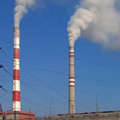2007年02月07日
摘譯自2007年2月2日ENS法國,巴黎報導;Nina L.編譯;蔡麗伶審校
- 如果大氣中的溫室氣體濃度達到前工業時代標準的兩倍的話,將很可能造成平均溫度提升約攝氏3度,變動範圍約在2度至4.5度間。
- 溫室氣體濃度達650ppm時,將可能使地球溫度提高約攝氏3.6度,達750 ppm時,為4.3度,達1000ppm時,則是5.5度,達1200ppm時,為6.3度。
- 地表平均溫度在過去100年(1906-2005)裡,已經增加了約0.74度。在未來則會每20年便升高0.2度。
- 僅計算海洋範圍擴大及冰山融化的影響,21世紀末海平面將上升28至58公分(與1989至1999年間的海平面高度相比),2001年報告的推估值為上升9至88公分,這是由於人類目前對暖化現況更為瞭解,推估的數字也更為精準。然而,若溫度繼續上升、冰棚持續融解,到2100年之時,海平面也很有可能上升到1公尺之多。上一次北極地區溫度上升到比現在更高的溫度,導致冰塊體積縮減、海平面上升4-6公尺,是在大約12萬5千年前。
- 海上浮冰在南北極區均會有縮減情形。北極區海面的冰塊面積自1978年起,每10年便減少約2.7%,夏季更是減至7.4%以上。
- 許多地區冰雪覆蓋的面積更縮減許多,尤其在春季。20世紀的後半時期,北半球土壤結冰的情形在冬春相交季節,每10年減少最高達到7%。而在過去150年裡,北半球河川湖泊結冰的時間,平均一世紀延後了5.8天,而解凍時間卻提早6.5天。
- 二氧化碳及甲烷目前在大氣中的含量,遠遠超出前工業時代的含量(最遠可溯至65萬年前):二氧化碳的濃度已從前工業時代的280 ppm上升至2005年時的379 ppm;而甲烷量更從715 ppb上升至2005年的1774 ppb。
The IPCC Working Group I report, "The Physical Science Basis," concludes:
 If atmospheric concentrations of greenhouse gases double compared to pre-industrial levels, this would "likely" cause an average warming of around 3°C (5.4°F), with a range of 2 to 4.5°C (3.6 - 8.1°F).
If atmospheric concentrations of greenhouse gases double compared to pre-industrial levels, this would "likely" cause an average warming of around 3°C (5.4°F), with a range of 2 to 4.5°C (3.6 - 8.1°F). - A greenhouse gas level of 650 parts per million (ppm) would "likely" warm the global climate by around 3.6°C, while 750 ppm would lead to a 4.3°C warming, 1,000 ppm to 5.5°C and 1,200 ppm to 6.3°C.
- The world’s average surface temperature has increased by around 0.74°C over the past 100 years (1906 - 2005). A warming of about 0.2°C is projected for each of the next two decades.
- The best estimates for sea-level rise due to ocean expansion and glacier melt by the end of the century (compared to 1989 – 1999 levels) have narrowed to 28 - 58 cm, versus 9 - 88 cm in the 2001 report, due to improved understanding. However, larger values of up to one meter (39 inches) by 2100 cannot be ruled out if ice sheets continue to melt as temperature rises. The last time the polar regions were significantly warmer than at present for an extended period, about 125,000 years ago, reductions in polar ice volume caused the sea level to rise by four to six meters.
- Sea ice is projected to shrink in both the Arctic and Antarctic regions. The extent of Arctic sea ice has already shrunk by about 2.7 percent per decade since 1978, with the summer minimum declining by about 7.4 percent per decade.
- Snow cover has decreased in most regions, especially in spring. The maximum extent of frozen ground in the winter/spring season decreased by out 7 percent in the Northern Hemisphere over the latter half of the 20th century. The average freezing date for rivers and lakes in the Northern Hemisphere over the past 150 years has arrived later by some 5.8 days per century, while the average break-up date has arrived earlier by 6.5 days per century.
- The amounts of carbon dioxide and methane now in the atmosphere far exceed pre-industrial values going back 650,000 years.
- Concentrations of carbon dioxide have already risen from a pre-industrial level of 280 ppm to around 379 ppm in 2005, while methane concentrations have risen from 715 parts per billion (ppb) to 1,774 in 2005.
全文及圖片詳見 ENS報導






